Another popular tropical plant species that stands out for its unique foliage is the Monstera adansonii plant. Indeed, it is not only widely sought after by many plant lovers due to its striking structure and unique characteristics but also its relatively low maintenance plant care. Therefore, it will equally leave each audience with awe, interest, and curiosity!
This article will tell you everything you need to know if you plan to get this gem–from growing, caring, and keeping your Monstera adansonii thriving!
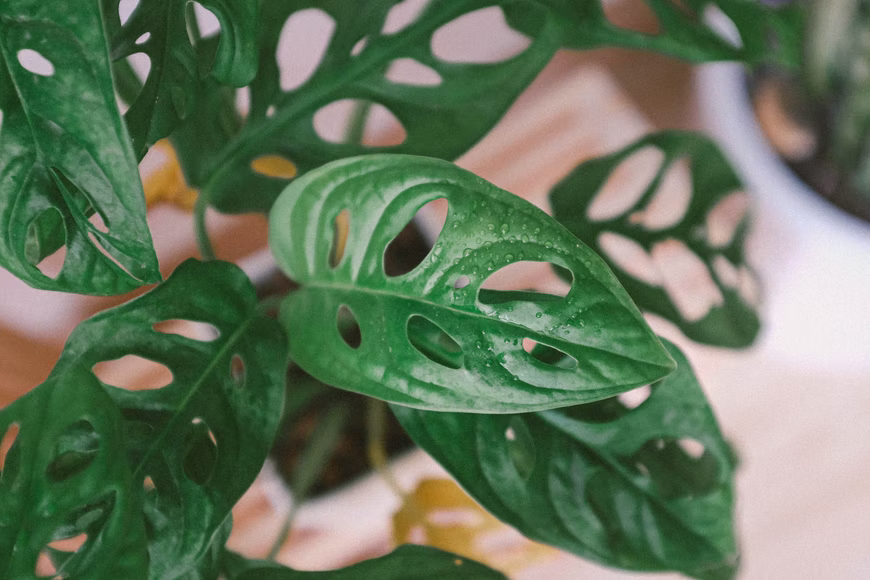
Monstera Adansonii Profile
General Information
The Monstera adansonii is an epiphytic vine belonging to the same family of aroids, Araceae. It is native to South Mexico and Tropical America (Central and South America), where it grows naturally as a rainforest, outdoor plant. Other famous Monstera plants include Monstera obliqua and Monstera deliciosa.
The Monstera plant however may also be grown indoors. It can grow up to 3 to 5 feet tall as a houseplant. It may even climb into large trees, up to 6 meters long, thanks to its aerial roots that can absorb moisture from the surrounding air.
It is striking and will add additional greenery, beauty, and uniqueness to any indoor setting, thanks to its green waxy leaves with unique holes and splits. It also produces flowers that may eventually turn into edible fruits.
Etymology
The Monstera adansonii plant got its name due to its peculiar foliage characteristics. The Monstera genus comes from the Latin word monstrum meaning monster.
It is also called the Swiss Cheese plant due to its elliptic holes and fenestrations on its leaves. Common names of this plant include Adanson’s Monstera, Tarovine, and Mountain Ears.
Flowering
The flowers of the monster plant are spiky with spathes that turn green. The fruit is covered with scales that are shed when it matures. If you live in a tropical climate, you may see these fruits after the first three years of growth.
Season Of Interest And Purchasing
This plant grows actively from spring through summer. Therefore, you may want to purchase this plant during those times to supplement it with the right food and requirements.
Growth
It is easy for this gem to grow as long as you know the ideal growth conditions for these plants. Particularly, you need to always be attentive to its water, light, soil, and temperature requirements. The plant is a fast grower.
RELATED: A Yellow Nightmare: 7 Reasons Why Your Monstera Plant Is Changing Color
Monstera Adansonii Overview
| Scientific name | Monstera adansonii |
| Common name/s | Swiss Cheese Vine, Tarovine, Mountain Ears, Adanson’s Monstera |
| Family | Araceae |
| Growth Habit | Epiphyte/Vine/Liana |
| Height and Spread | As a houseplant, 3-5 ft tall. On large trees, up to 6 meters long. |
| Classification based on life cycle | Perennial |
| Origin and Distribution | South Mexico and Tropical America |
| Climate Zone | Generally warmer climate |
| USDA Plant Hardiness Zone | USDA Zone 10 – 12 |
| Color | Evergreen with elliptic holes and fenestrations |
Care Tips
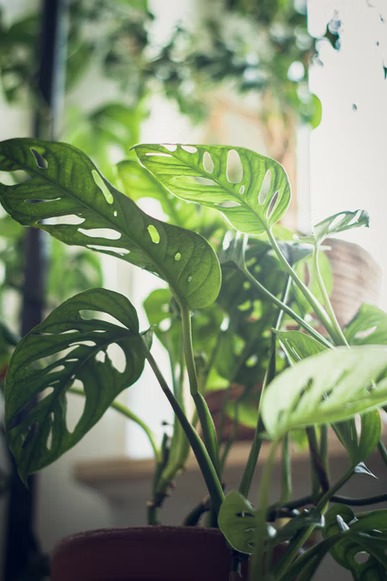
Light Requirement
Since the Monstera plant naturally grows in warm, humid jungle environments, they thrive in bright indirect light. It may still succeed in lower light conditions, but these may cause its growth to lag. And so, make sure that during the winter months, they get enough light. In this exception, you can grow them in direct sun.
Consequently, too much light may also be detrimental to this plant. To know whether your plant is receiving too much direct sun is if you see browning and yellowing on the leaves. If you see these signs, make sure to transfer your plant to a room that best gets bright, indirect sunlight. For example, you may place them in south-facing rooms or windows.
Temperature Requirement
Tropical plants such as the Monstera vine love warm environments. Therefore, they need to be kept in ambient temperatures around 60 to 80 degrees Fahrenheit and never below 55. Make sure that this plant does not go through sudden temperature drops too often, as this can stress the plant and cause permanent damage.
In addition, avoid exposing the plant to cold drafts from doors and windows and strong, blowing air from heating and cooling vents.
Water Requirement
Although naturally hailing from a tropical environment, the Monstera plant does not like it when it gets overwatered. This is because Overwatering may cause root rots that prevent the plant’s roots from further developing. To avoid this, make sure that the plant’s soil is well-draining and slightly dried out before watering again.
Having a watering schedule for your plant may help give proper attention to its moisture. However, do not let the plant wilt or get completely dried out, as it may kill it. Instead, please keep track of your watering to ensure the proper moisture levels for it to thrive and grow.
Humidity Requirement
The Monstera plant thrives in highly humid areas like any tropical rainforest plant. However, the usual household air may not be humid enough for this plant. In this case, you might need to add moisture to its environment for ideal growth.
To do this, you may use a spray bottle to spray the leaves of the Monstera a couple of times daily. The use of pebble trays with water or a room humidifier may also be necessary, if not better.
Soil Requirement
The plant needs to have a lightweight, fresh potting mix that is well-draining. You may also add organic matter like mushroom compost. Avoid heavy, compacted soils to avoid overwatering and the problems that come with it.
There is a lot of decaying organic matter in tropical jungles like leaves, sticks, and barks, so you may also simulate this type of environment if you wish to. You may add orchid bark and peat moss.
A soil pH of 5.5 – 7.0 is also the optimum range for the Swiss Cheese vine.
Fertilizer Requirement
The organic matter added to your soil is not enough for this plant, and you still need to fertilize it at least once a month when it’s actively growing. After that, you may use tropical plant fertilizer or all-purpose plant food.
Typically, these tropical plants need less phosphorus so use a fertilizer formulated for tropical plants ideally with higher nitrogen and potassium to phosphorus ratio. Added iron and magnesium may also be beneficial to your plant. Make sure also to use a well-draining mix and a slow release fertilizer to avoid over-fertilizing your plant.
There is no need to fertilize your Monstera during the fall and the winter as it is not the growing season.
Space Requirement
A mature Swiss Cheese vine grows about 6 meters tall. Make sure that you have a large enough pot (they love to be pot-bound) according to its size.
RELATED: How To Propagate Monstera: Everything You Need To Know
Growing And Planting Tips
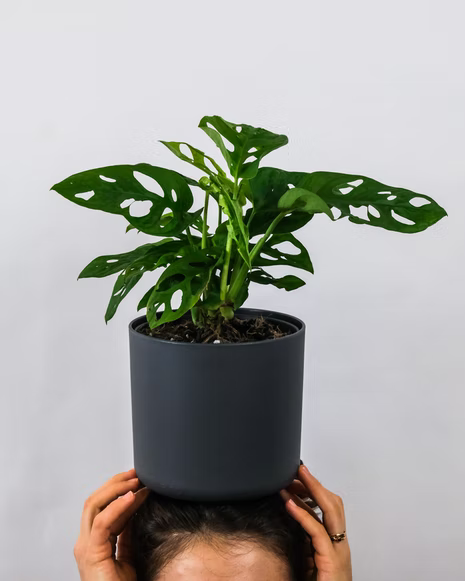
Propagation
It is very easy to propagate Monstera adansonii plant. Just make sure to use a clean, sterile instrument to cut it below the leaf node. The cuttings are then dipped in rooting powder and planted directly in moist fertilizer to start new plants.
You may also put them in water to grow roots for planting at a later time. Cuttings in water in glass may also make good ornaments or displays on walls or shelves.
Pruning
It is recommended to prune the Monstera adansonii plant to control its height and width. First, make sure you use a clean, sharp pair of scissors; better if pruning shears. Then snip off the end of the vine below the node, careful not to cut into the node itself.
Potting And Repotting
The Monstera plant loves to be pot-bound:
- Check the drainage holes for roots to know if your plant needs repotting. If roots are growing out of it, your plant may need a bigger pot. Before repotting, add fresh fertilizer and organic matter to the bottom of the new pot.
- Tap the plant out of the current pot and then push the root ball firmly into the new pot with soil.
- Pat down the soil to ensure there aren’t any air pockets.
- Ensure that the newly repotted plant has enough moisture by watering and misting it.
RELATED: The Monstera Is Loose! How To Save Your Droopy Plant
Monstera Adansonii Care
| Light | Bright indirect light |
| Temperature | 60-80 degrees Fahrenheit |
| Water | Once a week, increased in summer, decreased in winter |
| Soil | Light-weight, fresh, well-draining |
| Fertilization | Regular household fertilizer, once a month |
| Space | Minimal space |
| Propagation | Stem cutting propagation |
| Blooming | Rarely blooms, enough sunlight and maturity needed |
| Pruning | Regular pruning |
| Potting | Regular potting mix, use of mushroom compost and organic decaying matter |
Problems And Troubleshooting
Wilting
Wilting may be a result of overwatering or underwatering. When you see your plants wilting, take immediate action by checking the soil’s moisture level. You can do this by using a moisture meter or sticking your finger an inch to two into the soil.
If it is dry, you need to water the plant with demineralized water and mist the leaves. If it is too wet, tap the plant out of the pot onto a paper towel or plastic bag. Next, inspect the roots for root rot and gently cut them away if there are any. After this, replace the wet soil with fresh, loose dry soil as instructed above.
Diseases
Any plant can be susceptible to diseases if not properly taken care of. Particularly, plants of this family are affected by Septoria Leaf Spot and Alternaria Leaf Spot, resulting in fungal growth. Usually, these are also due to over-watering the plants.
Take action immediately when you see yellowing (Septoria) or brown spots (Alternaria). You can treat your plants with a copper-based fungicide and be attentive to the watering conditions, so it does not happen again.
Pests
Unfortunately, the Monstera plant is also not resistant to common pests. Common pests include fungus gnats, aphids, spider mites, and thrips. They usually show up when the plant is exposed to other infected plants or if the plant is stressed from neglect or improper care. Yes, these pests can smell the plant’s stress!
To look for signs of insects and their activities:
- Check your plant’s leaves, undersurfaces, stems, fertilizers, and roots carefully.
- When you see any pests on leaves, wash them off with a damp sponge. If you see pests on the stems, use soapy water.
- If there are pests in the soil, treat them with neem oil or other natural pesticides.
- Check also for the surrounding plants to avoid further infection.
Monstera Adansonii Pests And Diseases
| Common Pests/Diseases | Symptoms | Treatment and Prevention |
Common diseases include crown rot, stem rot, root rot, leaf spot, fungal diseases, and Xanthomonas infection | Yellowish rimming around black or dark brown spots on leaves | Avoid overwatering. Keep soil dry. Avoid too high humidity.Proper ventilation is needed around the plant. Remove infected parts of fungal infections to avoid spreading. |
| Common pests include mealybugs, spider mites, aphids, fungust gnats, thrips, and scales | Visible insects on the surface | Spray plant with warm, soapy water. If infestation is present, use insecticide or neem oil. Use diatomaceous earth. |
Problems With People And Animals
Toxicity
The rest of the plant is slightly toxic to moderately toxic when ingested by humans and animals. When ingested, it can cause difficulty swallowing and excessive drooling. So make sure to place the plant out of reach from small children or pets.
Monstera Plants Meaning And Symbolism
Monsteras symbolize long life and honor and respect for elders and respected people. Therefore, they would make an ideal gift for the elderly and people we owe respect to.
Monstera Adansonii Symbolism And Meaning
| General Meaning | Longevity of life, |
| Symbolism | Honor and respect for elders and respectable people |
Landscaping And Gardening Ideas
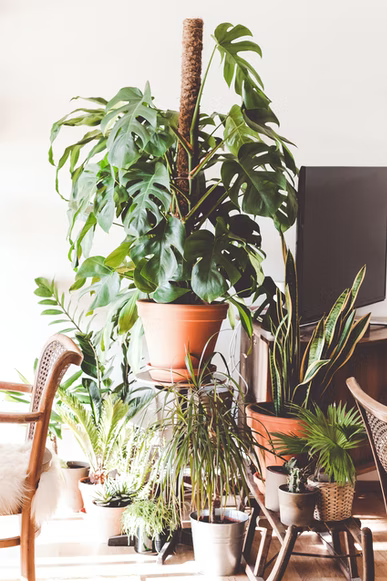
Companion Plants
Other tropical plants go well with Philodendrons and other Monstera species. Some plants you may consider include bird of paradise, areca palms, fire spike, heliconia, variegated arboricola, croton, chenille plant, and pentas. Some of these plants will have additional colors and hues of warm oranges and reds, perfectly complementing your excellent dark greens.
Landscaping Ideas
Swiss Cheese plants go well as accents inside a humid room or a cozy deck or patio. A full plant can also be placed in the corner of the house or along the entryway. Outdoors, it can be a filler plant for a garden corner, in between palm trunks, or under tall trees. It can also be placed near pools to add even more tropical vibes as long as it won’t get splashed.
| What to plant with | Bird of Paradise, Areca Palms, Fire Spike, Heliconia, Variegated Arboricola, Croton, Chenille Plant, Pentas |
| What NOT to plant with | Basically nothing |
Conclusion
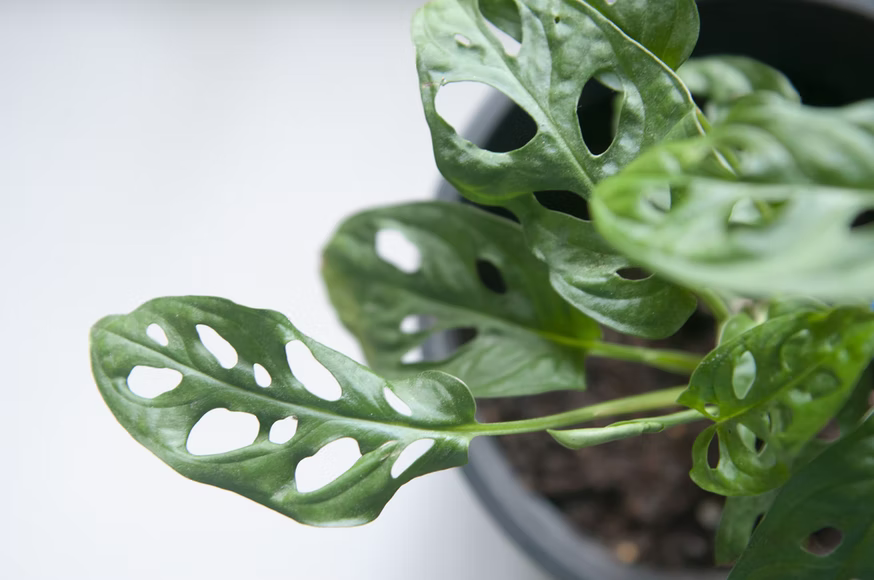
The Monstera adansonii, commonly known as the Swiss Cheese plant, is a stunning, tropical epiphytic vine with glossy leaves with trademark splits and holes upon reaching maturity. It is relatively easy to care for and grow as long as you provide it with the proper care and attention. Indeed, this plant may be the perfect addition to your tropical collection!
Frequently Asked Questions
Is the Monstera adansonii rare?
The Monstera adansonii is not a rare plant. On the contrary, it is a relatively common houseplant, easy to purchase, and commercially available worldwide.
Are Monstera adansonii easy to care for?
Definitely yes. The Swiss Cheese vine is suitable for beginners because it doesn’t need expert knowledge to grow this plant. In short, only minimum plant care is needed for this plant
Just make sure to give this plant the optimum requirements to thrive.
Should I mist my Monstera adansonii?
The Monstera adansonii, being a tropical plant, needs high humidity. If your place has low humidity, then misting is necessary every once in a while to keep the moisture level at its optimum.
Is Monstera adansonii an indoor plant?
Yes, the Swiss Cheese vine is an excellent indoor plant. Just make sure to put it near windows to receive sunlight and away from cold drafts.
How often do you water Monstera adansonii?
The Monstera plant hates to be overwatered. Only water the plant when the soil is completely dry. Check the topsoil first. If the soil is cracky, it is your signal to water the plant. As a rule, water the plant once per week. Increase it during summers.
Hope you like our Monstera adansonii article. Also, check out our other articles:
Philodendron Birkin: Its Most Informative Care, Propagation, and Watering Guide
11 Outdoor Foliage Plants To Arrange Your Garden Like A Professional Landscape Designer







